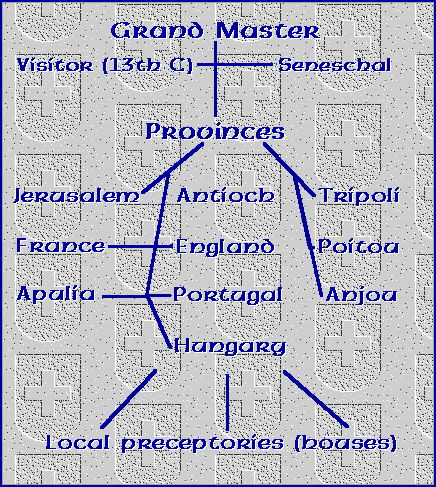

 he Order was initially very small,
consisting of a few strong knights who embarked on recruiting tours around
Europe. After receiving a significant boost from St Bernhard (see
Saint Bernard and the Rules of the Order, new
recruits flocked in fast, lured by both the spoils and adventure of war,
and also the adjoining salvation promised to their souls. The Knights Templar
provided a vent for the leftover sons of knightly families, who did not inherit
the title of their father but wanted to live the high life anyway.
he Order was initially very small,
consisting of a few strong knights who embarked on recruiting tours around
Europe. After receiving a significant boost from St Bernhard (see
Saint Bernard and the Rules of the Order, new
recruits flocked in fast, lured by both the spoils and adventure of war,
and also the adjoining salvation promised to their souls. The Knights Templar
provided a vent for the leftover sons of knightly families, who did not inherit
the title of their father but wanted to live the high life anyway.
 nitially it was not required that
the recruit be a son of a knight, but this later became a standard requirement.
The hierachy and ranks of the Order are somewhat confusing. Names of officials
vary considerably from one province to another. For example, the head of
the Order in England was at times called Grand
Prior, Grand Preceptor, and Master. Below him in rank were the Priors of
large estates, which were subdivided into Preceptories, governed by Preceptors.
These in turn ruled over the knights and Servientes. The head of the
Order in Ireland was never called Prior, though.
The Masters travelled their provinces and participated in major affairs,
and also in the reception of new recruits into the Order. The Master was
not a life-time appointment as can be seen from lists of Irish Masters, in
which some names first appear as Master and later as Preceptor.
nitially it was not required that
the recruit be a son of a knight, but this later became a standard requirement.
The hierachy and ranks of the Order are somewhat confusing. Names of officials
vary considerably from one province to another. For example, the head of
the Order in England was at times called Grand
Prior, Grand Preceptor, and Master. Below him in rank were the Priors of
large estates, which were subdivided into Preceptories, governed by Preceptors.
These in turn ruled over the knights and Servientes. The head of the
Order in Ireland was never called Prior, though.
The Masters travelled their provinces and participated in major affairs,
and also in the reception of new recruits into the Order. The Master was
not a life-time appointment as can be seen from lists of Irish Masters, in
which some names first appear as Master and later as Preceptor.
 s it grew, the Order was arranged
into ten provinces: Jerusalem, Tripoli, Antioch,
France, England, Poitou,
Anjou, Portugal, Apulia, and Hungary. Each province
was headed by a master and a commander, and above these officials were only
the Grand Master of the Order and his seneschal (deputy).
s it grew, the Order was arranged
into ten provinces: Jerusalem, Tripoli, Antioch,
France, England, Poitou,
Anjou, Portugal, Apulia, and Hungary. Each province
was headed by a master and a commander, and above these officials were only
the Grand Master of the Order and his seneschal (deputy).

 he office of the Visitor of the Order
is a 13th century addition. It was created for the master of the provinces
in Europe, and it was considered second to none but the
Grand Master. Still, not even the Visitor had
the power to call the chapter of the Order.
he office of the Visitor of the Order
is a 13th century addition. It was created for the master of the provinces
in Europe, and it was considered second to none but the
Grand Master. Still, not even the Visitor had
the power to call the chapter of the Order.
 t must be noted here that although
the total number of members in the Order probably reached some 15,000 to
20,000 brothers, by far not all of them were knights. On the contrary, some
researchers have put it forward that there probably was a 1 to 10 ratio between
knights and other members. Consequently, at any given preceptory there may
have been one to ten knights and up to a couple of hundred serving brothers.
One Templar house in France is on record as being very proud of its support
of one (1) knight, and yet the total staff was in the eighties.
Being a knight was expensive.
t must be noted here that although
the total number of members in the Order probably reached some 15,000 to
20,000 brothers, by far not all of them were knights. On the contrary, some
researchers have put it forward that there probably was a 1 to 10 ratio between
knights and other members. Consequently, at any given preceptory there may
have been one to ten knights and up to a couple of hundred serving brothers.
One Templar house in France is on record as being very proud of its support
of one (1) knight, and yet the total staff was in the eighties.
Being a knight was expensive.






